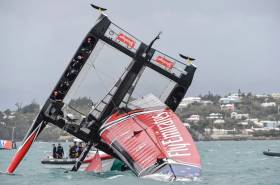Displaying items by tag: Andy Claughton
#AmericasCup - Emirates Team New Zealand suffered a high-speed pitch-pole just moments after the start of their America’s Cup play-off semi-final with Land Rover BAR on Tuesday (6 June), as previously reported on Afloat.ie.
But how did such a disastrous mistake happen? Land Rover BAR’s chief technology officer Andy Claughton shares his thoughts with Yachting World’s Elaine Bunting, suggesting a split-second error in assigning the NZ team’s daggerboard controls to the ‘cyclors’ that power its hydraulic systems, rather than the helmsman.
While that strategy has given the team an edge over their competitors in terms of fine control of ride height in lighter conditions, Claughton says the tradeoff was plain to see in their capsize in winds just below the 24 knots average limit.
Commenting more broadly on all sailors' performances in Bermuda over the week, Claughton also questions the “high-stakes dice rolling” format of concentrated short-course racing, which presents “a danger that you don’t give enough time for the cream to rise to the top.”
























































